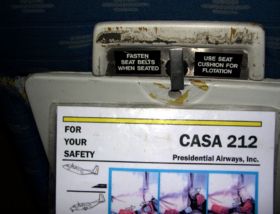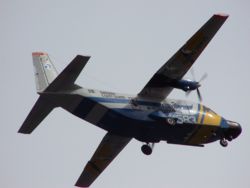PlaneSpottingWorld welcomes all new members! Please gives your ideas at the Terminal.
CASA C.212 Aviocar
The CASA C-212 Aviocar is a turboprop-powered STOL medium transport aircraft designed and built in Spain for civil and military use. C-212s have also been produced under licence in Indonesia by IPTN.
Contents
Development
During the late 1960s, the Spanish Air Force was still operating the already outdated Junkers Ju 52 and Douglas C-47. CASA developed the C-212 as a more modern alternative, with the first prototype flying on March 26 1971. In 1974, the Spanish Air Force decided to acquire the Aviocar to update its fleet.
When airlines took note of the type's success with the military, CASA developed a commercial version, the first examples of which were delivered in July 1975. In August 2006 a total of 30 CASA 212 aircraft (all variants) remain in airline service around the world.[1]
Description
The Aviocar has a high-mounted wing, a boxy fuselage, and a conventional tail. The tricycle undercarriage is fixed.
Variants
Series 100
- C-212A - original military production version. Also known as C-212-5, C-212-5 series 100M, and by the Spanish Air Force as the T-12B and D-3A (for medevac aircraft) 129 built
- C-212AV - VIP transport version, T-12C
- C-212B - six pre-production C-212As converted for photo-reconnaissance missions, TR-12A
- C-212C - original civil version
- C-212D - two pre-production C-212As converted for use as navigational trainers, TE-12B.
- NC-212-100 - Manufactured under licence in Indonesia since 1976, IPTN producing 28 NC-212-100s before switching to NC-212-200.
Series 200
Stretched version with uprated engines introduced in 1979. The CASA C-212-200 is also a popular skydiving aircraft, known for its large capacity, fast climb, and large tailgate exit ramp.
- C-212 series 200M - military version known as T-12D in Spanish service and Tp 89 for the Swedish Air Force. Specialised ASW and maritime patrol aircraft have been built from this version.
- NC-212-200 - C-212-200 build under licence by IPTN.
Series 300
Standard production version from 1987 on. Winglets for improved performance.
- C-212-M series 300 or Series 300M - military version
- C-212 series 300 airliner - 26 seat regional airliner
- C-212 series 300 utility - 23 seat civil utility version
- C-212 series 300P - civil utility version with Pratt & Whitney Canada PT6A-65 engines
Series 400
Slightly enlarged version first flying in 1997. US military designation is C-41.
Specifications (Series 300M)
General characteristics
- Crew: two pilots
- Capacity: up to 20 troops, 12 litters, or 2,820 kg (6,217 lb) of cargo
- Length: 16.15 m (53 ft 0 in)
- Wingspan: 20.28 m (66 ft 7 in)
- Height: 6.60 m (21 ft 8 in)
- Wing area: 41 m² (441 ft²)
- Empty: 4,400 kg (9,700 lb)
- Loaded: kg ( kg)
- Maximum takeoff: 8,000 kg (17,637 lb)
- Powerplant: 2x Garrett AiResearch TPE-331-10R-513C, 690 kW (925 shp) each
Performance
- Maximum speed: 370 km/h (230 mph)
- Range: 1,433 km (895 miles)
- Service ceiling: 7,925 m (26,000 ft)
- Rate of climb: 497 m/min (1,630 ft/min)
- Wing loading: kg/m² ( lb/ft²)
- Power/Mass: kW/kg ( hp/lb)
Armament
- up to 500 kg (1,100 lb) of weapons on two hardpoints. Typically, machine gun pods or rocket launchers.
Military Operators

- Abu Dhabi (UAE), Angola, Argentina, Bolivia, Burma (Myanmar), Chad, Chile, Colombia, Djibouti, Equatorial Guinea, France, Guinea, Ghana, Indonesia, Jordan, Lesotho, Mexico, Nicaragua, Panama, Paraguay, Portugal, South Africa, Spain, Sweden, Sudan, Suriname, Thailand, United States, Uruguay, Venezuela, Zimbabwe.
Incidents and Accidents
The CASA 212 has been involved in 71 hull-loss incidents with a total of 499 fatalities.[2] [3] This is a high occurrence, however the aircraft is generally not considered accident-prone as the cause of most crashes have been attributed to it being used in high-risk operations at low altitudes.
- On October 26, 2006 a Swedish Coast Guard CASA 212-200 (registration: SE-IVF/serial nr: KBV 585) crashed in the Falsterbo Canal during a surveillance mission, killing all four onboard.[4] [5] Eye-witness accounts suggest that the accident was caused by one of the wings of the aircraft somehow detaching from the plane.[6] The preliminary report from the Swedish Accident Investigation Board suggests that the right wing detached due to a fatigue crack which had developed in the load-bearing structure in the wing [7]. The investigation is ongoing.
- On November 15, 2006 a Mexican Navy CASA 212-200 Maritime Patrol (serial AMP-114) crashed in the sea in Campeche coast over the Mexican Gulf during a surveillance mission, all crew managed to survive, due to a smooth maneuver, reasons of the accident still unknown.[8]
References
- ↑ Flight International, 3-9 October 2006
- ↑ Accident statistics for CASA 212 from the Aviation Safety Network (English)
- ↑ List of incidents in the Aviation Safety Network Database (English)
- ↑ Press release from the Swedish Coast Guard (Swedish)
- ↑ Accident description, October 26, 2006 in the Aviation Safety Network Database (English)
- ↑ Four dead after coastguard plane crash, The Local, October 26, 2006. (English)
- ↑ Statens Haverikommission, (Swedish Accident Investigation Board) (English)
- ↑ SEMAR aircraft crashed in Mexican Gulf from the SEMAR Template:Sp icon
Related content
Related development:
Comparable aircraft:
Designation sequence:
- U.S. Military: C-29 - C-30 - C-31 - C-32 - C-33 - C-34 - XC-35 - C-36 - C-37 - C-38 - C-39 - C-40 - C-41 - C41 (New) - C-42 - C-43 - C-44 - C-45
Lists relating to aviation | |
|---|---|
| General | Timeline of aviation · Aircraft · Aircraft manufacturers · Aircraft engines · Aircraft engine manufacturers · Airports · Airlines |
| Military | Air forces · Aircraft weapons · Missiles · Unmanned aerial vehicles (UAVs) · Experimental aircraft |
| Notable incidents and accidents | Military aviation · Airliners · General aviation · Famous aviation-related deaths |
| Records | Flight airspeed record · Flight distance record · Flight altitude record · Flight endurance record · Most produced aircraft |
de:CASA C 212-200 es:CASA C212 id:CASA C 212 pt:CASA C-212-100 Aviocar sl:CASA C-212

